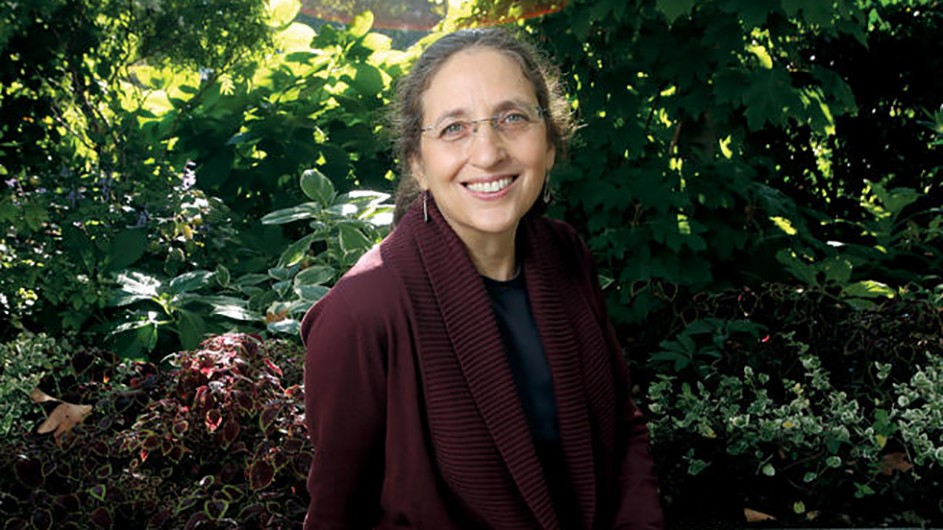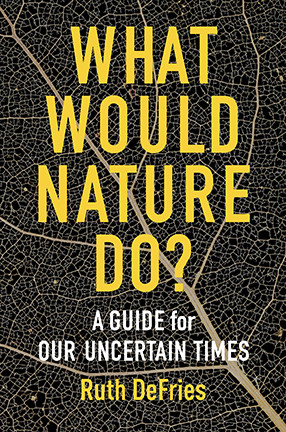What Nature Can Teach Us About Resilience
In her new book, Professor Ruth DeFries shares strategies from the natural world that can help us chart a path forward in these uncertain times.

Not long ago, the future seemed predictable. Now, certainty about the course of civilization has given way to fear and doubt. The pandemic, fires, storms, political upheavals, financial collapse, and other calamitous events lie ahead—or are already here. This is a time when the world feels less comprehensible and more dangerous, and no one—from individuals and businesses to governments—knows with certainty how to safely navigate next steps.
In her new book, What Would Nature Do? A Guide for Our Uncertain Times, University Professor Ruth DeFries, who teaches in the Department of Ecology, Evolution, and Environmental Biology, describes how a handful of strategies enable life to persist through unpredictable, sudden shocks. She discusses the book with Columbia News, along with what she’s reading now, the last book that made her laugh and cry, and who she would invite to a dinner party.
Q. How did you come up with the idea for this book?
A. Ever since I stumbled upon the great book The Origin of Wealth by Eric D. Beinhocker many years ago in a bookstore in New Delhi, I’ve been fascinated by the idea that complexity science has a lot to teach us about how we organize our human affairs. Nature is the ultimate complex system. With disruptions on the horizon from climate change and our inter-connected world, I was looking for those lessons. Ironically, I’ve been working on this book for more than five years, and the disruption from the pandemic hit right as I was finishing it.

Q. What are some of the time-tested strategies from the natural world that can help us chart a sustainable path forward, which you outline in the book?
A. The book is organized around four key strategies that have made it possible for life to survive for billions of years through asteroid crashes, wild swings in climate, and all kinds of shocks. These are: the ability to self-correct before catastrophe; diversity of different types of life to keep options open, redundant pathways in networks to keep water and other essentials flowing when disaster strikes; and the ability of individuals to decide where they go and what they do based on bottom-up observations of their surroundings rather than top-down control from a central authority.
Q. Are there historical events society faced that were solved using evolutionary or biological lessons or methods?
A. While researching for the book, I unexpectedly came across quite a few examples where people figured out that nature’s strategies work for their purposes although they probably did not recognize the link. Examples include circuit breakers in the stock market to prevent a crash, design redundancy in engineering, and the network design of the internet.
Q. As we face a pandemic winter, can you recommend any natural tricks to help us navigate the coming months?
A. Social insects surprisingly do not often suffer from epidemics even though they live tightly packed in nests. They keep their social networks clustered when threatened with a pathogen. That’s like our idea of pods with family and friends.
Read more about Professor Ruth DeFries' new book from the Earth Institute.
Q. What's on your reading list?
A. Next on my list is The Ministry for the Future by Kim Stanley Robinson. I’m generally not much of a science fiction reader, but people say it’s a fantastic read.
Q. What's the best book you ever received as a gift, and why?
A. The best gift while growing up was a subscription to National Geographic. Through the photography and stories, the magazine let me see that the world is a big, complicated place with all kinds of people.
Q. What's the last book that made you laugh?
A. I’m partway through Obama’s A Promised Land, and I’ve laughed hysterically at least a dozen times.
Q. The last book that made you cry?
A. I’m partway through Obama’s A Promised Land, and I’ve cried at least a dozen times.
Q. What are you teaching in the spring? How are you helping your students cope with online learning?
A. I’m teaching a very geeky, technical class on analysis of satellite data to map the Earth’s land surface. These methods let us see where humans are clearing forests, expanding agriculture, and constructing cities. The ability to map these changes, which is only possible on a large scale from satellites looking down on the Earth, is a first step to figuring out how society can better manage the planet. About online learning—the resilience of students has been amazing. Everyone is just trying to do the best that’s possible under the circumstances.
Q.You're hosting a dinner party. Which three academics or scholars, dead or alive, would you invite and why?
A. My ideal dinner party has my two adult children, their significant others, and my two little grandchildren at the table. Barring that possibility, my next choice would be the late Elinor Ostrom, who went up against entrenched dogma to show that people can solve their own problems, and was the first woman to receive the Nobel prize in economics. I’d also send invites to the greats who showed that change is possible—Nelson Mandela, Mahatma Gandhi, and Martin Luther King Jr.